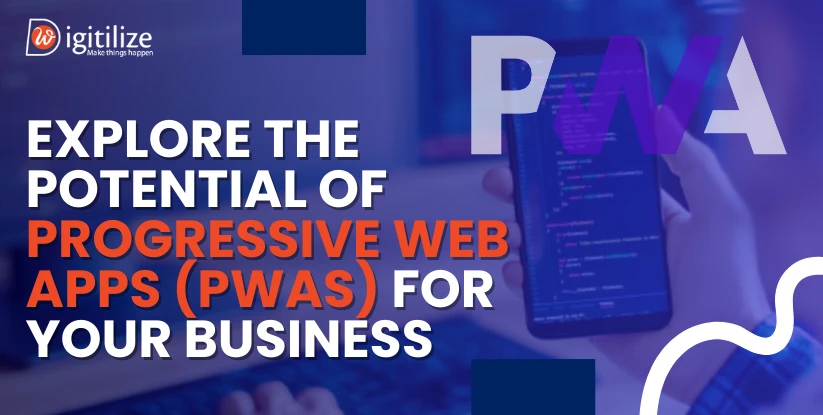Explore the Potential of Progressive Web Apps (PWAs) for Your Business
 Nowadays, the user experience is everything. Search engines are beginning to take user signals into account when ranking web pages in SERPs. As of present, 87% of consumers carry a smartphone with them. Because customers can communicate with businesses using any device, at any time, and from any location, apps gained popularity. Here PWA development UK come to the frame. We need to explore the potential of progressive web apps (PWAs) for your business.
In a sense, progressive web applications are more flexible and feature-rich than native apps. For your future mobile application, we assume you have already begun considering Progressive Web Apps for business. Thus, let’s attempt to investigate and comprehend PWAs—the newest development trend for mobile applications—in this article.
Nowadays, the user experience is everything. Search engines are beginning to take user signals into account when ranking web pages in SERPs. As of present, 87% of consumers carry a smartphone with them. Because customers can communicate with businesses using any device, at any time, and from any location, apps gained popularity. Here PWA development UK come to the frame. We need to explore the potential of progressive web apps (PWAs) for your business.
In a sense, progressive web applications are more flexible and feature-rich than native apps. For your future mobile application, we assume you have already begun considering Progressive Web Apps for business. Thus, let’s attempt to investigate and comprehend PWAs—the newest development trend for mobile applications—in this article.
What is PWAs, Progressive Web Apps?
Progressive Web Apps (PWAs) combine the best parts of native mobile apps and web development. They are built using standard web technologies like HTML, CSS, and JavaScript. PWAs load fast, work reliably, and offer a smooth user experience.
You can open a PWA on any device, PCs, tablets, or smartphones just by using a web browser. There’s no need to download anything from the app store.
Popular examples of PWAs include Flipboard, Gmail, Google Docs, and Twitter. You can access them straight from your browser. These apps feel like native apps and let you sign in from any device, anytime, anywhere. This is the main cause of these applications’ enormous rise in popularity. That’s why we need to explore the PWAs Business potential for your business.
Advantages of Progressive Web in App Development

-
Installation or manual upgrades are not necessary.
You don’t need the Play Store or App Store to use Twitter’s progressive web app. It runs right from your browser. No manual updates are needed either. New features and bug fixes appear automatically.
These smooth updates help more than just users. When everyone has the latest version, fewer people contact customer support. That’s because they don’t face old bugs or outdated issues. With a PWA, Twitter can roll out updates anytime—without bothering users or breaking their experience.
Web browsers can cache PWAs so they can be utilised even when they are not connected. This is fantastic news for companies who sell product catalogues since it enables buyers to peruse their offerings even when they aren’t online, which raises user engagement and might result in more sales.
-
Features unique to a certain platform
Benefits of PWAs for businesses from several platform-specific capabilities, no list of the primary benefits and drawbacks of PWAs can be considered comprehensive. Web push notifications may be sent by PWAs, for instance, and they can seem just like standard push notifications on the user’s home screen. That’s why we need to explore the potential of progressive web apps (PWAs) for your business. Aside from accessing locational data, they can start with a unique splash screen, run in full-screen mode, and modify the orientation of the display.
The good news for independent app developers and smaller companies that don’t want to pay Google’s $25 lifetime cost or Apple’s $99 yearly fee to get their app published is that PWAs are app store independent. Naturally, developers are also free to produce any app they want without being constrained by the rules and restrictions of Google’s and Apple’s app stores when they choose not to rely on an app store.
By 2023, mobile devices drove over half of all internet traffic. People now browse and shop across multiple platforms, mobile, desktop, and even in-store. This shift has pushed brands to rethink the user experience. Today’s users expect a seamless, omnichannel journey. To meet these expectations, websites must be responsive. That means the design should adjust to any screen size and match each user’s behavior. This is where responsive design becomes essential. It helps websites stay flexible and user-friendly across all devices. Progressive Web Apps (PWAs) take this a step further. They use modern technology to create fast, responsive, and reliable web application interfaces.
Making use of progressive web app features is the greatest way to use SEO to make the website more visible throughout search engine results pages. The fact that native applications are housed on mobile devices means they are not searchable online, which is a drawback. This isn’t the case because SEO benefits of PWAs may view them as web pages. Having said that, discoverability is not the only benefit PWAs offer over native apps. Hence, these include having an improved user experience (UX) and being quick, linkable, and indexable.
PWAs may be installed on a device, in contrast to standard web applications. Users will be able to access that app through an app icon, which will improve user experience and make it more integrated and smooth. Instead of opening a web browser window and entering a URL, users simply select the shortcut on their Home Screen to launch the application. PWAs can operate without an installation.
-
No Problems with Updating
Another problem that could affect how end users interact with the system is updates. PWAs, on the other hand, do not have these issues. PWA will update data automatically, saving you the trouble of asking your clients for permission every time. That’s why we need to explore the potential of progressive web apps (PWAs) for your business. So, you may easily notify your clients about updates by sending them a push notice.
Slow websites or applications are a major contributing factor to high bounce rates on websites. People don’t have the patience or the time to wait for lengthy loads. Using progressive web applications makes sense for many more reasons. PWAs provide a quick, enhanced, and seamless user experience, which lowers bounce rates. For instance, Superbalist’s cross-platform compatibility launch resulted in a startling 21% reduction in their bounce rate.

-
Constructing the Application Shell
The PWA’s core user interface is essentially the app shell. Give priority to a minimalist design strategy to guarantee quick loading times and seamless user experiences. Minimise the number of initial load requests and maximise the amount of all resources, such as CSS, JS, and pictures.
-
Putting Service Workers in Place
Write JavaScript code that will handle network requests, and cache results, and retrieve them when required. Update the service worker script often to guarantee new material and preserve the stability of the programme.
-
Making a Manifest for a Web App
This is a JSON file that contains PWA meta-data. Specific attributes include display characteristics, icon sets, start URL, short name, and name. So, make sure the manifest accommodates the desired device orientations and resolutions.
PWAs are capable of utilising a variety of device characteristics in addition to offline capability. Depending on your company objectives, include APIs for features like camera access, geolocation, and other things. Make sure that user privacy is protected and that permissions are requested in the right way.
Putting a testing plan into practice is an essential component of PWA development. Conduct thorough audits about online accessibility, performance, and best practices using technologies such as Lighthouse. To emulate, debug, and test across various devices, use Chrome DevTools and related technologies.
-
Putting the PWA into Practice
When all is satisfactory, deployment may begin. The PWA should be packaged for the appropriate platforms based on the intended audience. So, recall that PWAs aren’t just for mobile devices. Its characteristics are equally advantageous to desktop users.
Performance optimisation makes sure a PWA keeps its responsiveness and snappiness. Analyse and cut files on a regular basis, particularly multimedia and photos. Increase load times and decrease server requests by using the caching capabilities of browsers and service worker caching mechanisms.
-
Keeping an eye on and updating the PWA
A PWA is a living thing that needs consistent attention. Analytics tools are used to track user interactions, performance data, and any problems. Hence, update the PWA regularly to include security updates, new web standards, and APIs.
PWA Vs Native Apps

It’s not easy to say whether a native app or a PWA is better. Both have their pros and cons. What truly matters is how well the final product works for your target users.
Your decision should match your goals, technical needs, and what your users expect. When you understand what each option offers, you can choose the right bespoke application development solutions with clarity and confidence.
When responding to this need, you must carefully evaluate the features your application offers to provide an excellent user experience.
In this case, a documented quote and a budget estimate are crucial. You must ascertain the complexity of the newly developed feature and whether you need to engage more experts. Make sure you have sufficient funds for each growth step.
Think about if you can wait a full year for your native app to be published in the app store if you have tight deadlines and can’t wait that long.
Do you intend to make money off of your app? Which media outlets are you going to use to promote it? Which of the application’s access methods is the most convenient for your users? Thus, make sure you research your market, your competitors, and any potential viewers before putting your marketing plan into action.
It’s not easy to say if native apps or PWAs work better. Both have pros and cons. What really matters is whether the app meets the needs of your target users. The best choice depends on your goals, features, and how your users behave. When you understand what each option offers, you can choose the right bespoke application development solutions with confidence.
Our ability to assist in PWA projects
DigitilizeWeb has little expertise with online and mobile development services, but it has successfully finished projects, including progressive web apps. We’ve covered the essential points of PWA in this article, but it’s crucial to remember that every project is unique.
Hence, our staff is available to examine your unique needs and assist you in meeting them. If you think our experience can help you, please contact us so we can talk about how we can collaborate. For more follow us on LinkedIn.
Frequently Asked Questions
PWAs can function more quickly than responsive design, which is one manner in which they vary from it. According to recent research, PWAs outperform responsive design by a factor of 3.8.
Several companies have decided to follow the trend of creating progressive web apps every year. According to a Jaxenter poll, 46% of developers think PWAs are the way of the future, whereas only 14% thought the same about native mobile apps.
In fact, in places with poor internet, PWAs can provide a superior user experience. Consider Flipkart, an ecommerce company that enables people with a 2G connection to access the website.
No, that's one of the advantages of PWAs. Users can access them directly through a web browser without the need for downloading or installing from an app store. However, users have the option to add the PWA to their home screen for quick access.
PWAs provide a more immersive user experience with features like push notifications, offline access, and responsive design. These elements contribute to increased user retention and satisfaction.
Yes, existing websites can be transformed into PWAs. The process involves adding a service worker, implementing responsive design, and enhancing the site's functionality to meet PWA criteria.
 Nowadays, the user experience is everything. Search engines are beginning to take user signals into account when ranking web pages in SERPs. As of present, 87% of consumers carry a smartphone with them. Because customers can communicate with businesses using any device, at any time, and from any location, apps gained popularity. Here PWA development UK come to the frame. We need to explore the potential of progressive web apps (PWAs) for your business.
In a sense, progressive web applications are more flexible and feature-rich than native apps. For your future mobile application, we assume you have already begun considering Progressive Web Apps for business. Thus, let’s attempt to investigate and comprehend PWAs—the newest development trend for mobile applications—in this article.
Nowadays, the user experience is everything. Search engines are beginning to take user signals into account when ranking web pages in SERPs. As of present, 87% of consumers carry a smartphone with them. Because customers can communicate with businesses using any device, at any time, and from any location, apps gained popularity. Here PWA development UK come to the frame. We need to explore the potential of progressive web apps (PWAs) for your business.
In a sense, progressive web applications are more flexible and feature-rich than native apps. For your future mobile application, we assume you have already begun considering Progressive Web Apps for business. Thus, let’s attempt to investigate and comprehend PWAs—the newest development trend for mobile applications—in this article.




